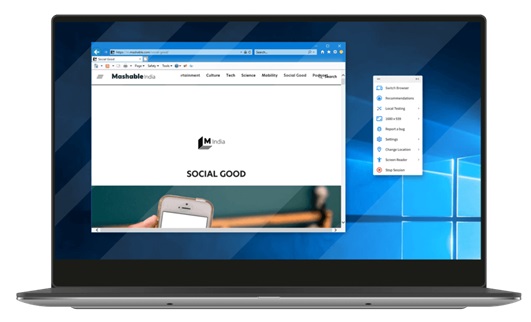Internet Explorer (IE) developed by Microsoft was another famous internet browser of the early time. Internet Explorer online was initially an integral part of Windows and from its release in 1995, became almost synonymous with web browsing for many. Continuing the development every new version of IE incorporated new features and improvements for the rapidly growing online environment. Internet Explorer is not as enticing as the modern and full-fledged browsers based on Google Chrome, Mozilla Firefox, as well as Microsoft Edge.
Many companies and governments continue to work with it and support it due to legacy systems and apps built for Internet Explorer. Online developers and testers are to ensure that their websites and online applications are compatible with Internet Explorer. IE testing discovers potential compatibility issues, ensuring an ideal impression for each site visitor.
Rich media web browsers have evolved over time along with the development of the web. Newer browsers like Chrome, Firefox, and Edge run the latest web standards fast and securely. Microsoft now has more focus on Edge, a web browser that is based on Chromium.
However, there are still many companies that are transitioning to new systems, and they may utilize IE for certain purposes. Consequently, maintaining support for old systems and providing an option for compatibility with older versions while encouraging consumers to upgrade to new browsers for a safer and enhanced browsing experience is necessary.
Explanation of Online Testing for Internet Explorer
Internet Explorer (IE) online testing aims at checking and examining the web application’s functionality, usability, and compatibility with the help of IE. As to developers and testers, numerous versions of IE can be tested within such virtual environments without many devices or installations. This method also reduces and rationalizes the cost of testing.
Online Testing: An Understanding
Technology has enabled one to conduct online tests; therefore, there is a need to become familiar with online tests.
- Remote access: Online testing systems do away with the need to install and set up local programs and processes. This is useful for organizations that have distributed or even remote employees.
- Scalability: Online platforms can easily be expanded to experiment with multiple rhythms of IE as soon as the need arises, without requiring the installation of new hardware or software.
- Maintenance: It is the role of online testing services to update and continuously manage such environments to ensure that testers have updated environments and new security fixes at their disposal.
- Cost-Effectiveness: Online testing platforms could benefit organizations by allowing them to avoid the costs that come with maintaining a large amount of physical testing facilities and equipment.
Online Testing Tools: Benefits for Internet Explorer
Let us take a look at the benefits of using online testing tools for IE.
- Efficiency: These tools make it easier to set up and perform tests with different versions of IE, thus cutting down on testing time.
- Extensive Coverage: There are numerous options to choose the desired Internet Explorer versions, and people can download them now from the testing sites, ensuring that the compatibility issues will be revealed.
- Cooperation: Cloud environments are also helpful in enhancing collaboration between team members since it is easy to share test results and comments.
- Real-world circumstances: Due to the aspects of mimicking real-life environments and situations, these platforms might offer a more realistic example.
Step-by-Step Guide to Setting Up an IE Testing Environment
Here is a step-by-step guide to setting up an IE testing environment:
-
Choosing the Right Online Testing Tool
- Features Evaluation: Compare the number of features offered by different online testing systems. Look for tools and functionality, for example, checking tools, test automation, and live testing.
- Check Compatibility: Make certain that the platform under test is compatible with the required copy of Internet Explorer.
- Review Pricing Plans: Make comparisons of the various plans provided and select a plan that meets your budgetary capacity and testing requirements. There are also always free trials, so you can test the tool before subscribing to the service.
-
Creating an Account
- Sign Up: Go to the website of the platform selected and create an account with them. Any additional trials that are provided should be used to familiarize oneself with the software’s options.
- Subscription Plans: It is worth choosing a package depending on the kind of testing that is required to be done. Some of these have limited features; paid plans are good for minimal use.
-
Configuring the Testing Tool for IE
- Access the Dashboard: This is normally done by entering your username and password, and then you are directed to a page with a list of options such as log-in, control panel, or dashboard.
- Select the Browser and Version: Find Internet Explorer in the list of other compatible browsers. Select the particular releases of Internet Explorer, namely IE 8, 9, 10, and 11, for carrying out the tests.
- Configure Testing Environment: Configure the testing environment using the operating system (Windows 7, Windows 8, Windows 10), and screen resolution. In some operating systems, there may be other additional settings, such as network limiter and GPS location.
-
Initiating Tests
- Live Testing: Regarding manual testing, make a selection of the live testing option available. By doing this, you will be able to use your website as a virtual local computer, which will open the Internet Explorer version that you have selected on the virtual machine.
- Automated Testing: In the event that this is your most preferred way of testing, avail of the available automation features on the platform. You should upload your test scripts, like Selenium scripts, and then set up the test runs for the specific versions of IE.
-
Running Tests and Collecting Results
- Execute Tests: Execute your tests and check the results as the process advances in parallel. Almost all platforms have an interface or console that can be used to monitor the results of running tests.
- Analyze Results: After all tests are conducted, it is important to analyze the results. Focus on compatibility concerns, including the efficiency and effectiveness of the device. Some of the platforms provide reporting and logging facilities that even show the errors and areas requiring attention.
-
Debugging and fixing issues
- Debugging Tools: Utilize the platform diagnostic utility to make the necessary corrections. Screenshots, network logs, and console logs might be useful for diagnosing issues and fixing them.
- Retest: Once you have identified various problems that affect your website, correct them and redo the testing to confirm whether the problems are solved. Continue testing until it matches up with the fully compatible state.
Hopefully, these instructions will assist you with the proper setting up and utilization of online testing tools to ensure your web apps run properly on Internet Explorer for those who utilize this browser.
Best Practices for Internet Explorer Online Testing
Here are some of the best practices that one should follow for Internet Explorer online testing:
-
Cross-Version Testing
- Importance: Web standards and features supported by IE are realized to a different extent depending on the version. This is crucial in order to deliver a consistent user experience across the product and its updates.
- Strategy: By either using website analytics or user data, you can identify the versions of Internet Explorer that are still in use by many people. Testing generally embraces Internet Explorer 8, 9, 10, and 11.
- Implementation: Use the available online testing tools to launch your site on each of the aforementioned versions. Any differences or problems that pertain to each variant should be documented.
-
Responsive Design Testing
- Importance: The pages designed through the responsive web design methodology might not appear efficient in operation when accessed through Internet Explorer, in contrast to the new generation of browsers. Testing is important to make sure that your site is well presented on different devices and that it operates correctly.
- Strategy: Learn how your site performs on a desktop screen, on a tablet device, or even on mobile. The layout changes are mostly observed at the breakpoint, and hence, the different layouts are focused at these breakpoints.
- When using the online testing tool for this kind of testing, use the responsive design mode. It simulates different devices and screen sizes. Check if the site seamlessly responds to different resolutions and if usability is affected.
-
Functionality Testing
- Importance: It is crucial to pay much attention to the proper functioning of all the link-sensitive items as long as Internet Explorer influences end users’ experiences significantly.
- Strategy: First, you label critical portions of the website, like form submission buttons, site navigation menus, and media players.
- Implementation: These functions should be tested manually, or test scripts can be run to check their efficiency. Focus on the JavaScript compatibility issue and on events.
-
Performance testing
- Importance: Internet Explorer can be described as slower in its speed than today’s modern internet browsers. The target response times and load times need to be kept within reasonable limits.
- Strategy: Monitor the page load, the time for the scripts to run, as well as the rendering time.
- Implementation: Some of the tools could be obtained free of charge from internet performance testing sites. To increase speed, delete comments and extra spaces from CSS and JavaScript files. Also, compress images and use fewer HTTP calls.
-
Accessibility Testing
- Importance: Ensuring your website is accessible makes it easier for the physically disabled and anyone with other physical disabilities to search and use your site.
- Strategy: Determine if your website conforms with the Web Content Accessibility Guidelines (WCAG).
- Implementation: Perform an accessibility test of the page to check for items such as color contrast, keyboard only, and screen reader. As stated above, accessibility needs the following modifications to be made.
Cloud-hosted tools have revolutionized how we test browser compatibility. This is especially true for older versions of Internet Explorer. Cloud systems usually do not need much local installation. They also do not need much physical hardware. This is because the solutions can be accessed remotely. For teams that are likely to work remotely or in different locations, accessibility is equally important.
You can test each of these browsers on various operating systems. You can use any of the programming languages supported by LambdaTest. It works as an Internet Explorer online testing tool.
- Test automation possibilities: A wide range of tools are presented on this website for simplifying the test process and ensuring mutual compatibility with various versions of IE.
- Access Multiple Versions: Run checks on the Internet Explorer for different versions of Internet Explorer, starting from IE 8 to IE 11, with an aim to cater to an absolute cross-version check.
- Real-Time and Automated Testing: Customize its use for various tests by performing both manual and automated testing. Among the highlights, the tool supports Selenium-based automation, which makes it possible to perform script execution in IE environments of various levels.
- Integrated Debugging Tools: Make use of the debugger that is offered within the present language to be used so as to solve problems as they occur and as fast as possible. Tools such as visual regression testing, console output, and network output help in the debugging process.
- Testing for responsive design: You can use the responsive design mode of LambdaTest to ensure whether your web apps are in proper shape and how they work on different resolutions.
- Use the LambdaTest DevTools extension for accessibility testing for Chrome.
You can use LambdaTest’s advanced options to ensure that the frontend of your web apps is stable and identical for each user. This is true no matter what browser they use, if the company’s services are part of the testing process. It enhances the overall quality and performance of your web applications in the most efficient and cost-cutting manner.
Conclusion
Adhering to the compatibility to Internet Explorer is still important when it comes to designing websites especially to organizations that still employ the use of the outdated browser.
They used online test tools and best practices. This helped the developers overcome the major IE hurdles. Some key strategies include practices such as doing cross-version testing. They also involve ensuring the designs work as intended. They boost performance and obey security and accessibility standards.
Despite the fact that current browsers have more features, distinguish versions, and are faster, Internet Explorer is still needed for certain audiences. Staying loyal to the approach of checking every move and button brings unity. It makes the user’s experience seamless across all the browsers. Updates on new testing methods and sources will help developers. They help with the concerns of browser compatibility as the web evolves.


















